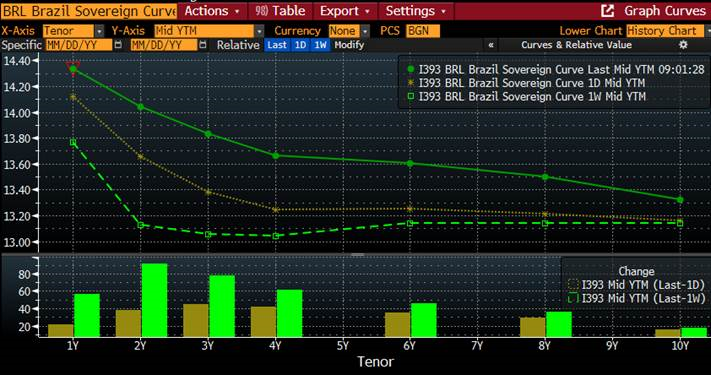How to Lose Market Confidence in 10 Days
November 17, 2022
Read Time 2 MIN
LATAM Populism
Brazil’s “fall from grace” continued to this morning, as the market got startled by President-elect Luiz Inácio Lula da Silva’s fiscal package, which calls for significant modification of the spending cap and larger social spending. Well, this U-turn should not be completely surprising, given Lula’s populist credentials. But the market was hoping that Lula 3.0 would be different, hence a fairly elevated long positioning going into the elections runoff – which, in turn, explains the extent of the market correction both in local rates (see chart below) and the currency. Given that Lula’s fiscal loosening can slow Brazil’s disinflation going forward, the central bank might be forced to issue a “warning shot” in the form of a rate hike in order to reassure the market that the situation is under control. Brazil’s local swap curve started to price in this eventuality, with +65bps of tightening in December-March, and the market sees practically no room for rate cuts in 2023.
Asia Rate Hike Frontloading
Indonesia had its fair share of fiscal concerns during the pandemic and immediately after, but its fiscal outlook is currently better than in Brazil (the budget deficit is expected to narrow to less than 3% of GDP in 2023). Still, the central bank is powering ahead with sizable rate hikes to bring inflation back to target as soon as possible – and this includes today’s 50bps increase in the 7-day repo rate. The statement sounded hawkish – signaling another hike in December, and paying special attention to the impact of global uncertainty and rate differentials on the currency (=imported inflation). Indonesia’s neighbor – Philippines – also opted for a large 75bps hike, as inflation shows few signs of abating.
EM Policy Coordination
Local bonds in Central Europe had a better week than Brazil, but they are still at the bottom of the GBI-EM year-to-date “league table”. The Russia/Ukraine war had a huge impact on the 2022 performance, but fiscal concerns in Hungary and Poland are also to blame. Hungary was slow to implement fiscal adjustment after the pre-election spending spree, and there are legitimate concerns that Poland might re-open fiscal spigots in the run up to the 2023 parliamentary elections. The consensus currently expects Poland’s budget deficit to widen by more than 1% of GDP next year – and this most likely means additional bond issuance. Can local banks and institutions fully absorb this supply? Why Poland decided to issue a U.S. Dollar-denominated bond recently? Importantly, can the central bank afford to remain “frozen” for longer? Stay tuned!
Chart at a Glance: Brazil Local Bonds – Elections Have Consequences

Source: Bloomberg LP.
Related Topics
Related Insights
February 26, 2024
January 04, 2024
October 27, 2023
PMI – Purchasing Managers’ Index: economic indicators derived from monthly surveys of private sector companies. A reading above 50 indicates expansion, and a reading below 50 indicates contraction; ISM – Institute for Supply Management PMI: ISM releases an index based on more than 400 purchasing and supply managers surveys; both in the manufacturing and non-manufacturing industries; CPI – Consumer Price Index: an index of the variation in prices paid by typical consumers for retail goods and other items; PPI – Producer Price Index: a family of indexes that measures the average change in selling prices received by domestic producers of goods and services over time; PCE inflation – Personal Consumption Expenditures Price Index: one measure of U.S. inflation, tracking the change in prices of goods and services purchased by consumers throughout the economy; MSCI – Morgan Stanley Capital International: an American provider of equity, fixed income, hedge fund stock market indexes, and equity portfolio analysis tools; VIX – CBOE Volatility Index: an index created by the Chicago Board Options Exchange (CBOE), which shows the market's expectation of 30-day volatility. It is constructed using the implied volatilities on S&P 500 index options.; GBI-EM – JP Morgan’s Government Bond Index – Emerging Markets: comprehensive emerging market debt benchmarks that track local currency bonds issued by Emerging market governments; EMBI – JP Morgan’s Emerging Market Bond Index: JP Morgan's index of dollar-denominated sovereign bonds issued by a selection of emerging market countries; EMBIG - JP Morgan’s Emerging Market Bond Index Global: tracks total returns for traded external debt instruments in emerging markets.
The information presented does not involve the rendering of personalized investment, financial, legal, or tax advice. This is not an offer to buy or sell, or a solicitation of any offer to buy or sell any of the securities mentioned herein. Certain statements contained herein may constitute projections, forecasts and other forward looking statements, which do not reflect actual results. Certain information may be provided by third-party sources and, although believed to be reliable, it has not been independently verified and its accuracy or completeness cannot be guaranteed. Any opinions, projections, forecasts, and forward-looking statements presented herein are valid as the date of this communication and are subject to change. The information herein represents the opinion of the author(s), but not necessarily those of VanEck.
Investing in international markets carries risks such as currency fluctuation, regulatory risks, economic and political instability. Emerging markets involve heightened risks related to the same factors as well as increased volatility, lower trading volume, and less liquidity. Emerging markets can have greater custodial and operational risks, and less developed legal and accounting systems than developed markets.
All investing is subject to risk, including the possible loss of the money you invest. As with any investment strategy, there is no guarantee that investment objectives will be met and investors may lose money. Diversification does not ensure a profit or protect against a loss in a declining market. Past performance is no guarantee of future performance.
PMI – Purchasing Managers’ Index: economic indicators derived from monthly surveys of private sector companies. A reading above 50 indicates expansion, and a reading below 50 indicates contraction; ISM – Institute for Supply Management PMI: ISM releases an index based on more than 400 purchasing and supply managers surveys; both in the manufacturing and non-manufacturing industries; CPI – Consumer Price Index: an index of the variation in prices paid by typical consumers for retail goods and other items; PPI – Producer Price Index: a family of indexes that measures the average change in selling prices received by domestic producers of goods and services over time; PCE inflation – Personal Consumption Expenditures Price Index: one measure of U.S. inflation, tracking the change in prices of goods and services purchased by consumers throughout the economy; MSCI – Morgan Stanley Capital International: an American provider of equity, fixed income, hedge fund stock market indexes, and equity portfolio analysis tools; VIX – CBOE Volatility Index: an index created by the Chicago Board Options Exchange (CBOE), which shows the market's expectation of 30-day volatility. It is constructed using the implied volatilities on S&P 500 index options.; GBI-EM – JP Morgan’s Government Bond Index – Emerging Markets: comprehensive emerging market debt benchmarks that track local currency bonds issued by Emerging market governments; EMBI – JP Morgan’s Emerging Market Bond Index: JP Morgan's index of dollar-denominated sovereign bonds issued by a selection of emerging market countries; EMBIG - JP Morgan’s Emerging Market Bond Index Global: tracks total returns for traded external debt instruments in emerging markets.
The information presented does not involve the rendering of personalized investment, financial, legal, or tax advice. This is not an offer to buy or sell, or a solicitation of any offer to buy or sell any of the securities mentioned herein. Certain statements contained herein may constitute projections, forecasts and other forward looking statements, which do not reflect actual results. Certain information may be provided by third-party sources and, although believed to be reliable, it has not been independently verified and its accuracy or completeness cannot be guaranteed. Any opinions, projections, forecasts, and forward-looking statements presented herein are valid as the date of this communication and are subject to change. The information herein represents the opinion of the author(s), but not necessarily those of VanEck.
Investing in international markets carries risks such as currency fluctuation, regulatory risks, economic and political instability. Emerging markets involve heightened risks related to the same factors as well as increased volatility, lower trading volume, and less liquidity. Emerging markets can have greater custodial and operational risks, and less developed legal and accounting systems than developed markets.
All investing is subject to risk, including the possible loss of the money you invest. As with any investment strategy, there is no guarantee that investment objectives will be met and investors may lose money. Diversification does not ensure a profit or protect against a loss in a declining market. Past performance is no guarantee of future performance.

